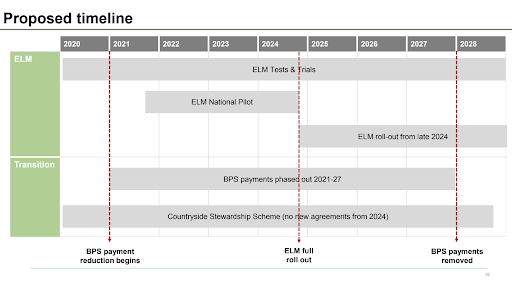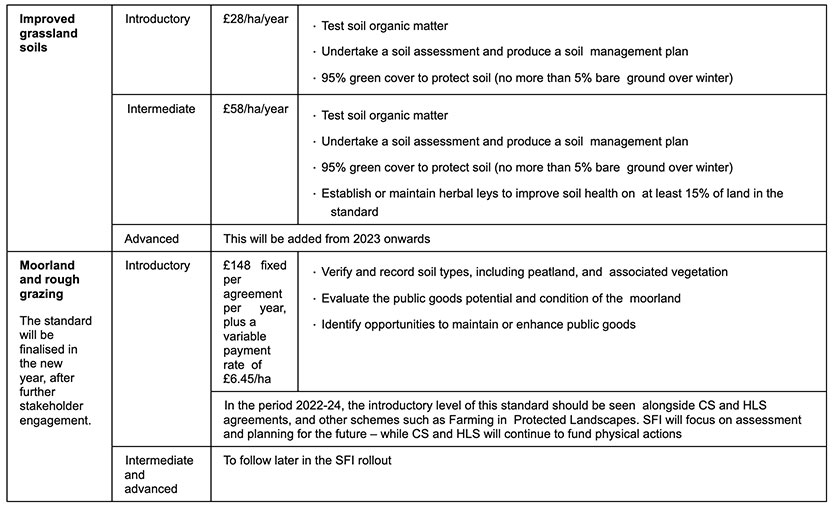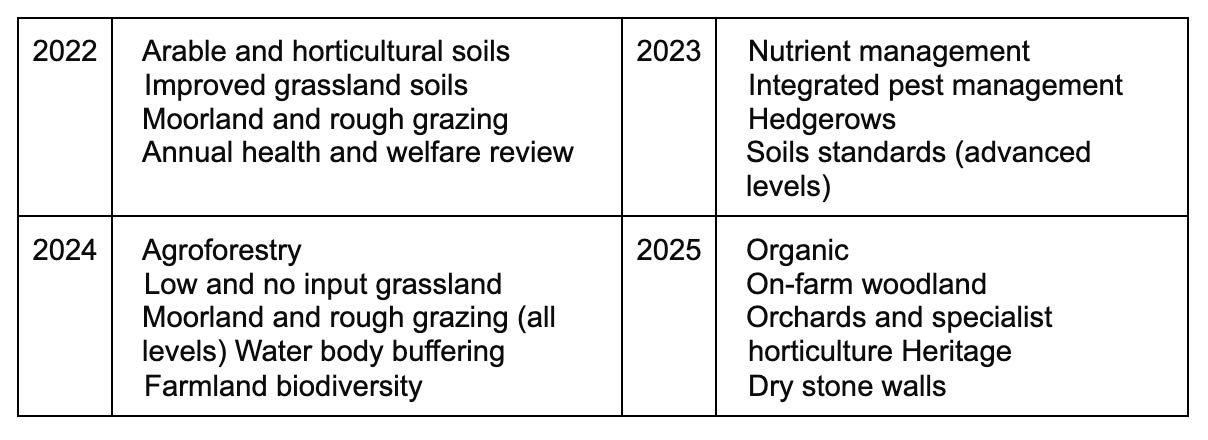The Path to Sustainable Farming: An Agricultural Transition Plan 2021 to 2024
There are three parts to the new Environmental Land Management Schemes that will replace the Basic Payment Scheme:
- Sustainable Farming Incentive
- Local Nature Recovery
- Landscape Recovery
We hope that this page will give you a concise overview of what we know so far about each part and when they will be rolled out.
All the information here is drawn from Savills’ excellent pdfs on each part of the ELM schemes.

Sustainable Farming Incentive
Overview:
The Sustainable Farming Incentive (SFI) is one of the new Environmental Land Management (ELM) schemes that Defra has created to incentivise and reward farmers for providing public goods alongside food production, including climate change mitigation, supporting biodiversity and improving water quality. The SFI will be structured around standards. Farmers will be able to choose as many standards as they like. Each standard has three levels of ambition:
- Introductory
- Intermediate
- Advanced
Farmers in England who are eligible for the Basic Payment Scheme (BPS) will be eligible for SFI. SFI will be operated at land parcel level, so farmers do not have to enter their whole farm, and there is no minimum or maximum amount of land that can be put into the scheme. Cross-border land parcels will not be eligible for SFI in the scheme’s early rollout.
SFI agreements will last for three years, with some flexibility for farmers to amend them every 12 months from their start date. At this point farmers will be able to increase the ambition levels, add land and additional standards to their agreements.
Roll out and application:
- The pilot is ongoing, with rollout from 2022. The full range of standards will launch in 2025.
- An application window for SFI will open in 2022 (exact dates tbc early 2022) and the first round of payments will be received before the end of the year.
- The SFI application window will be a minimum of 10 weeks and should not clash with the BPS application window.
- Farmers can access the SFI scheme alongside other schemes such as Countryside Stewardship.
- After 2024, farmers will be able to apply for and enter into SFI at any time of the year, rather than being restricted to a defined application window.
The current SFI standards that farmers will be able to apply for are:
- Arable and horticulture soils
- Improved grassland soils
- Moorland and rough grazing
- More to come in next 3 years
How will payments work?
Savills have put together this very helpful breakdown of what farmers will be paid for each level of ambition for each standard:


SFI payments will be paid in quarterly instalments, beginning three months after each agreement starts. Each instalment will represent one quarter of an annual payment. This is intended to help farmers manage their cashflow within the year. There will be no capital payments available under the SFI standards in 2022, although they will be introduced into SFI later in the rollout.
For more information on the details of these standards, please see Defra’s most recent SFI policy paper, released December 2021. You can also view the rest of the excellent SFI overview from Savills here, which includes more information on eligibility.
Future SFI standards:
Defra is refining and introducing new standards each year. Here are the standards planned for the next four years:

Local Nature Recovery
Overview:
The Local Nature Recovery (LNR) scheme focuses on paying for locally targeted actions to ‘make space for nature’ within the farmed landscape and the wider countryside. Actions will include tree planting, flood management, habitat management, access and heritage assets. The aim is to encourage collaboration in local areas.
LNR is being described as the ‘improved and more ambitious successor’ to the Countryside Stewardship (CS) scheme. Defra is planning to take the best aspects of CS and incorporate elements of collaboration, localisation and blended finance in order to make LNR more appealing, effective and less bureaucratic.
The scheme will offer a range of options, similar to CS, allowing farmers to build an agreement that suits their setting and management objectives. Defra wants the scheme to be straightforward, with a simpler application and administration process. LNR agreements will cover multiple years, their length being dependent on the options selected. There will be flexibility to allow land managers to add more options or land into their agreement over time.
Roll out and application:
Defra intends to test and pilot the new proposals for LNR with up to 500 participants, who will represent a range of sectors and include those already in and those not in agri-environment schemes. How pilot participants will be recruited will be announced later.
Farmers, foresters and land managers will be able to apply for LNR. Defra expects agricultural land to make up the majority of LNR agreements and is working to ensure the scheme will be accessible to tenants and those farming common land.
There will be an early version of LNR available to a limited number of land managers in 2023 as part of Defra’s plans for testing and rolling out the scheme. The scheme will then be rolled out across the whole country by the end of 2024. Defra has promised that there will be a smooth way for people to transition from existing CS schemes into ELMs from the end of 2024 onwards.
LNR will be complimentary to the Sustainable Farming Incentive (SFI), and farmers will be able to enter both LNR and SFI, provided the actions are compatible and Defra is not paying for the same actions twice.
From 2024 both SFI and LNR will be accessible through a streamlined and simple digital service that will show each individual applicant all the options available to them.
How will payment work?
Local Nature Recovery will support farmers’ contribution to national environmental priorities, including:
- Reversing the decline in biodiversity
- Improving water quality
- Reaching net zero emissions
- Building the resilience of the environment to climate change
- Improving air quality
- Natural flood management
- Coastal erosion risk mitigation
- Heritage and access
Defra will publish the full list of available options later in 2022. This will include more detail on scheme rules and proposed payment rates.
LNR will also support the management of feeding, shelter and breeding areas for wildlife on arable farms and management and restoration of upland and lowland peat and moorland. The scheme will include targeted measures to support the recovery and reintroduction of particular wildlife species and to tackle non-native invasive species. It will include options for the delivery of nature based solutions for water, including restoring rivers, flood plains, streams and riparian habitats. Finally, the scheme will also provide options for managing and creating trees and woodlands, including agroforestry, traditional orchards and on-farm tree planting. It is worth noting the England Woodland Creation Offer will remain the main scheme for woodland creation until 2025.
Read the full Savills debrief here for more information on private finance, collaboration and land management plans and Savills commentary on the proposed plans.
Landscape Recovery
Overview:
The Landscape Recovery (LR) scheme is the most environmentally ambitious of the ELM schemes, intended to deliver long-term, large-scale, landscape and ecosystem recovery projects in England.
LR projects will deliver a wide variety of environmental outcomes and support local environmental priorities. The intention is that they will also make an important contribution to national targets, such as:
- the 25 Year Environment Plan
- the UK’s Net Zero by 2050 target
- the government’s pledge for 30% of the UK’s land to be protected by 2030
- the UK’s new legally binding species abundance target.
LR will support the establishment of England’s Nature Recovery Network and Green Finance Strategy. It will support large scale projects such as:
- peatland restoration
- floodplain creation
- rewetting bogs, fens and salt marshes
- priority habitats
- woodland creation
This first wave of pilot projects are likely to focus on two themes:
- Recovering and restoring England’s threatened native species: birds and insects
- Restoring England’s streams and rivers: improving water quality, biodiversity and adapting to climate change.
These themes set the projects’ primary objectives and it is likely that the themes supported will be expanded in future. Projects are expected to deliver co-benefits too. In selecting the initial themes, Defra has focused on areas in which it believes cooperation amongst landscape scale land managers can make a real difference.
Roll out and application:
Defra wants to pilot ten LR projects between 2022 and 2024 which would deliver over 20,000 hectares of wildlife-rich habitat.
For each project, Defra will create a bespoke agreement. Nothing that Defra has proposed is set in stone, so there is room for the scheme design to change based on feedback. It is clear that Defra wants the LR scheme to be co-designed with stakeholders.
The LR scheme will be open to applications from sites of 500 to 5,000 hectares. This needs to be a contiguous block of land. Applications can be made by landowners or land managers as well as collaborative groups and partnerships with other organisations. Public bodies are also eligible, provided they apply in collaboration with another land manager. The project area does not need to be the whole of a land manager’s holding – part can be entered as long as the area thresholds are met.
Double funding will not be allowed – applicants cannot be paid twice for the same activity or outcome. It is likely that if projects are currently receiving funding from other parts of ELM or Countryside Stewardship, Defra will suggest that the project transitions out of those existing agreements and fully into LR. Because of the long term nature of these schemes and objectives, each project needs to prove secure management for at least 20 years; tenants and landowners will therefore need to work together.
Defra has provided illustrative examples of what eligible projects might look like. For an example project, take a look at Savills’ full LR pdf.
Defra highlighted that grazing will be considered on a case-by-case basis, as it can have a positive impact on biodiversity in certain areas but can also release carbon on peaty soils.
Defra is aiming to invite bids for the first wave of 10 pilot projects before the end of 2021, however it said that this timing depends on feedback from its initial proposals. The application window could be six weeks long, and detailed guidance will be published ‘at least a week in advance of applications opening’.
Projects that are successful in the initial application phase will be supported (with a certain amount of funding) to undertake project development starting in early 2022. Defra aims to scale-up delivery of the LR scheme from 2024.
How will payment work?
Each project will have bespoke payment rates that are negotiated during project development. Defra has stressed it is still working on how to define payment rates and is very keen to hear ideas as to how it can innovate in this space. It wants to secure good value for money, to only pay for additional outcomes, and not pay for the same action twice.
Defra has stressed that the scheme will ‘crowd in’ private finance, and that finding opportunities to leverage private finance are important. It has proposed several blended funding models. To read more on these models, read the full LR pdf from Savills here.

